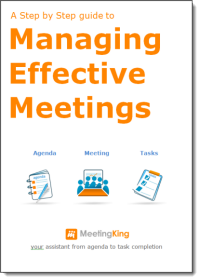It’s not easy changing company policies, or getting people to change their habits, or even introducing new tools into a workplace. People will always talk about how things have changed and the old ways of doing things were so much better, or they might even continue working the way they always did, ignoring any efforts to change how the company works. The same thing happens whether your business upgrades to a new version of Microsoft Office, when Facebook changes the way the Timeline looks, or even when you switch to a new brand of coffee.
It’s the same with meetings. People are used to meetings being a place where they push around bits of paper for an hour and munch on some biscuits, while they mentally write down their Saturday shopping list. They are used to meetings that don’t really get anything done, where decisions are postponed, and where nothing is written down, so that the next meeting has to start all over again. Even when you try to introduce a new system, or a new way of running meetings, it’s not easy to make the change.
So sometimes, you need to shake things up a little.
Stand up meetings
A tried and true method from the world of Agile development, where daily ‘standups’ are held. The daily stand-up meetings are an excellent place to keep the team updated about their various tasks and help each other where help is needed, and standing up prevents the meetings from carrying on for longer than strictly necessary. You don’t have to jump into daily meetings, certainly if it isn’t necessary, but standing up can certainly keep everyone on their feet. Literally.
Early/Late
Most meetings are held around lunch time (either just before or just after). Hold your next meeting at 8 a.m. sharp, or at 6 pm. Again, this doesn’t have to be the start of a brand new policy for all meetings, but for the first few you have this way, the complete change in the meeting schedule can be the baseline to show that other meeting conventions have changed as well.
Remove distractions
Turn off people’s cellphones, laptops, tablets and even Google Glasses, if they are lucky enough to have them. This is a bit drastic but again, you want to shake things up and hammer home the point that the meeting culture has changed, and you are taking the changes seriously – and you expect your team to do the same.
Bottom line is, don’t be afraid to make some significant changes to the way you manage your meetings. In the end, they will become more productive, and become what they should have been in the first place – an engine to drive your company forwards.


